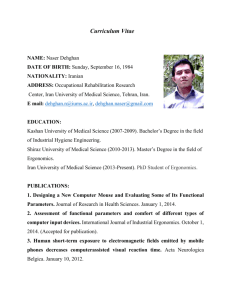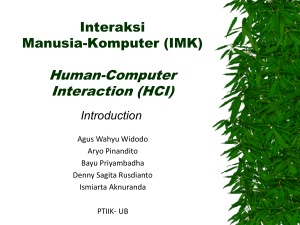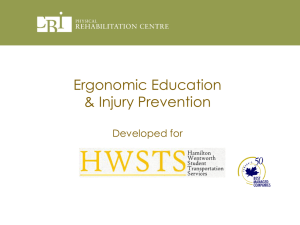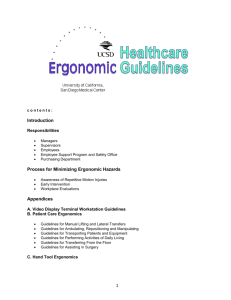Ergonomics
advertisement
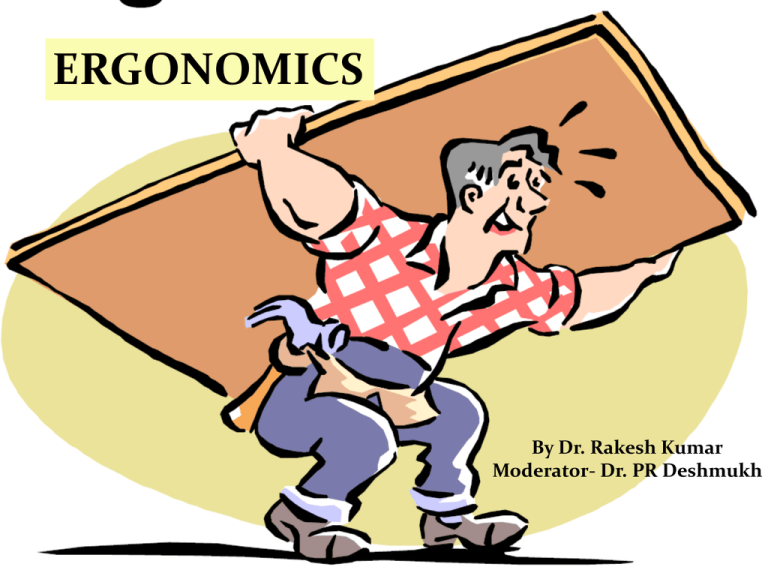
ERGONOMICS By Dr. Rakesh Kumar Moderator- Dr. PR Deshmukh Framework Introduction History What is Ergonomics Ergonomics- a Multidisciplinary science Human Engineering Work Physiology Occupational Biomechanics Anthropometry Workplace Contributing Factors Work related injuries and diseases Principles of ergonomics Ergonomics Job Analysis Methods Benefits of ergonomics What Are Ergonomic Improvements? Engineering Improvements Administrative Improvements Safety Gear Examples of ergonomic improvements References Introduction Poor job design and workplace design is one of various occupational hazards Large and increasing numbers of workers affected by poor work design Increasing prevalence of health problems related to a lack of ergonomics at work Ergonomics is an integral part of any advanced occupational health services History Ancient man made pebble tools and scoop from antelope bones 17th century- Bernardino Ramazinni wrote about work-related complaints in his book "De Morbis Artificum " 1857- Term‘Ergonomics’ was first coined by Wojciech Jastrzebowski Early 19th century- Frederick W. Taylor was a pioneer of ergonomic approach World war II- Prompted interest in human-machine interaction 1970 The Occupational Safety and Health Act of 1970 (U.S.) Purpose to "assure so far as possible every working man and woman a safe and healthful working conditions to preserve human resources.“ Institutes for occupational health and safety in India: 1. Central Labour Institute, Mumbai (1960) 2. National Institute of Occupational Health, Ahmedabad What is Ergonomics Ergo – from the Greek word meaning work Nomos – from Greek word meaning natural laws Definition: Science and practice of designing jobs and workplaces to match the capabilities and limitations of the human body. (OSHA, 2000) i.e, Science of fitting the job to the person rather than making the person fit the job Objective: To improve the fit between the physical demands of the workplace and the employees who perform the work i.e, To achieve best mutual adjustment of man and his work for improvement of human efficiency and well being Ergonomics- a multidisciplinary Science Human Engineering - Study of the principles of mechanics and anatomy in relation to human movement Work Physiology- Static or Dynamic work Occupational Biomechanics – a disciplinary science which explains the characteristics of biological system of the human body in mechanical terms. Anthropometry - Study of human body measurements. Workplace Contributing Factors Aspects of work tasks which can lead to fatigue, musculoskeletal disorder (MSD) symptoms and injuries, or other types of problems •Heavy, Frequent, or Awkward Lifting •Pushing, Pulling or Carrying Loads •Working in Awkward Postures •Hand Intensive Work •Repetitive motions •Forceful exertions •Vibration Physical/mental capability, preexisting conditions, etc Noise, temperature, humidity etc Work-related Injuries and Disorders Work related muskulo-skeletal are most common Also known as: Repetitive Strain or Stress Injury (RSI) Cumulative Trauma Disorder (CTD) Overuse Syndrome Occupational disorders of the soft issues like muscles , tendons, ligaments, joints & nerves Usually occur slowly over time due to repetitive injuries to the soft tissues and nervous system Symptoms of WMSD: Discomfort, Pain, Numbness, Tingling, Burning, Swelling, Tightness, loss of flexibility Risk of injury depends upon: Duration, Frequency & Intensity of exposure or combinations of risk factors Injuries Common sites Cause Bursitis knee, elbow, shoulder Kneeling, pressure at the elbow, repetitive shoulder movements Carpal tunnel syndrome wrist Repetitive work with a bent wrist. Use of vibrating tools. Epicondylitis Elbow Repetitive work, often strenuous Ganglion Back of hand or wrist Repetitive hand movement Osteo-arthritis Any joint Awkward liftting, pulling, pushing Tendonitis Any site Repetitive movements Tenosynovitis Any site Repetitive movements, often nonstrenuous Tension neck or shoulder Neck or shoulders Sustained awkward postures Trigger finger Fingers Repetitive movements. Excessive gripping Basic Ergonomic Principles • Work activities should permit worker to adopt several different healthy and safe postures. • Muscle forces should be done by the largest appropriate muscle groups available • Work activities should be performed with joints at about mid-point of their range of movements(esp. head, trunk, upper limb) Ergonomics principles at Workstation •Consider ergonomic factors like head height, shoulder height, arm reach, elbow height, hand height, leg length, and hand and body size while designing a workstation Occasional work area Usual work area frequently used work area 50 cm 80-100 cm 25 cm Ergonomics principles during sitting position No wrist support Wrist supported and straight No foot rest Foot supported Bending foreward Back straight and supported Ergonomics principles at workstation Ergonomics principles during standing position • Do pelvic tilt intermittently •Keep a chair nearby for taking rest intermittently • Workstation should have footrest Pelvic tilt Chair available Footrest Ergonomics principles during using hand tools and controls Poor control position Good control position Ergonomics principles during heavy physical work Keep back straight Place feet in walking position Stand close to objects and feet slightly apart Take help of others Use both hands and grip with whole hand To summarize the ergonomic principles… Straight back rule Workstation at the level of umbilicus Arm space Pelvic tilt Center of gravity Neutral Position No window adjacent to work station Benefits of ergonomics Reduced fatigue and discomfort Helps to prevent injuries like MSDs Improved quality of life Improved comfort, morale and job satisfaction Improved quality of work Improved productivity and reduced workers’ compensation costs and employee turnover Reduced sickness absenteeism Ergonomics Job Hazard Analysis Methods Consist of various techniques for taking a systematic look at jobs and work tasks It breaks a job into its various tasks, describes them, measures and quantifies the ergonomics risk factors inherent in the task, identifies conditions contributing to the risk factors, and determines corrective measures Help decide which jobs and specific tasks may contribute to problems e.g, Ergonomics Awareness Checklist- simple Others complex and sophisticated methods Methods vary according to types of work activities they address. e.g, workstation design, types of work, work environment Steps: 1. Conduct an initial job review 2. List Hazardous Jobs 3. Conduct a Risk Analysis 4. Prioritize Hazardous Jobs 5. Describe the hazards in each step 6. Take ergonomic modification 7. Evaluate it for risk reduction What Are Ergonomic Improvements? Definition: Changes made to improve the “fit” between a job and the capabilities of the employees performing it Three strategies : • Engineering improvements • Administrative improvements • Safety gear or personal protective equipment(PPE) Engineering Improvements Engineering improvements include rearranging modifying, redesigning, or replacing: • Workstations, • Equipment, • Tools, • Packaging Reduce or eliminate existing hazards Most effective strategy Best time is when new facilities, processes, or work procedures are being planned Administrative Improvements Reduce exposure to the hazard by controlling behaviors through design of safety rules and safe work practices and procedures Include changing work practices or the way work is organized Require continual management and employee compliance to ensure that the new practices and policies are effective Administrative Improvement Options 1. Providing variety in jobs 2. Adjusting work schedules and work pace 3. Providing recovery time (i.e., muscle relaxation time) 4. Ensuring regular housekeeping and maintenance of work spaces, tools, and equipment 5. Increase workforce & Reduce workload 6. Training in recognition of risk factors Safety Gear or Personal protective equipment Provides a barrier between the worker and the hazard source Reduces the duration, frequency, or intensity of exposure Includes gloves, knee and elbow pads, respirators, ear plugs, safety goggles, , aprons, safety shoes, and hats Examples of ergonomic improvements 1. Use food quality tools 2. Wear antivibration gloves 3. Lubricate tool regularly 1. Put shock absorber in vechile 2. Use well designed seat in vechile Awkward forward bending Unsupported static posture Forceful extension Job dissatisfaction Repetitive movements Intensive hand use References: 1. Your health and safety at work: A collection of modules. International Labor Organization. 2. Ergonomics – The study of work. OSHA:2000 3. Ergonomics guidelines for manual material handling. NIOSH publications; Colombia parkway:2007 4. Sutton SC. A guide to ergonomics. 5. Cohen A et al. Elements of ergonomics programme. NIOSH publications; Colombia parkway: 1997. 6. Park K. Park’s Textbook of Preventive and social medicine. 18th edition. Bannout publication; Jabalpur: 2006. p.658-9. 7. Internet: http://www.ergoweb.com THANK YOU
